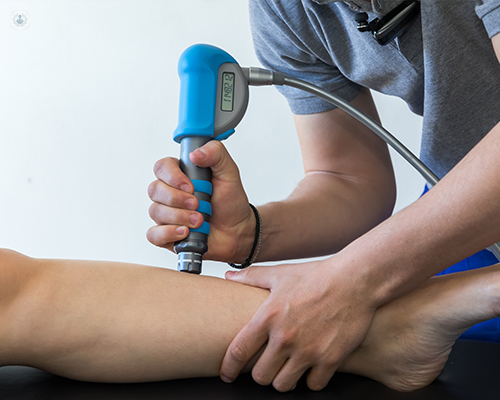Can shockwave therapy (SWT) help me recover from my injury?
Written by:Shockwave therapy (SWT) is used to stimulate healing for a variety of injuries e.g. tendonitis, plantar fasciitis and muscle pains. Mr Stefen Weitzel, a leading London orthopaedic surgeon and expert in SWT, provides you with a concise guide to this therapy to help you discover if it can help you recover from your injury.

What exactly is shockwave therapy?
Shockwave treatment (SWT) is a treatment using pulsatile sound and pressure waves to stimulate the body’s own cellular self-healing mechanisms. The treatment is administered by direct skin contact (with ultrasound gel) with an applicator machine hand-held by a health professional, usually a specially trained doctor or physiotherapist.
What kind of injuries can it be used for?
It is usually used for areas of chronic musculoskeletal injury e.g. Achilles tendonitis, plantar fasciitis and muscle strains. More recently, it has also been found to be beneficial for arthritis, back pain and other conditions.
Is the procedure painful?
There may be some discomfort or mild pain experienced during the treatment. This is experienced differently by patients and can be made more tolerable by modifying the frequency and intensity during the treatment. Most patients tolerate this well, but some may require taking oral painkillers or anti-inflammatories before the treatment session.
How effective is this therapy?
Overall, effectiveness varies and depends on the individual and the condition. Studies have shown good and excellent outcomes in up to 70-80% of cases. Often, the outcome is improved by undergoing physiotherapy & stretching take place around the same time as having SWT.
How many sessions are needed to see an improvement?
Usually, three sessions that take around 10 minutes each and that are spaced one to two weeks apart are needed. Sometimes, in cases of very chronic conditions or with an incomplete response, more sessions (up to six) are needed.
Are there any side-effects?
Apart from the discomfort felt during the treatment, there are no significant side-effects. For specific tendons e.g. the Achilles tendon, there may be an increased risk of rupture if SWT is used soon after steroid injections. Therefore, the advice is to leave at least four to six weeks between a steroid injection and shockwave treatment.
Are you considering shockwave therapy or any other treatments for your condition? Mr Weitzel is available for face-to-face and online video consultations – visit his profile to get in touch.


